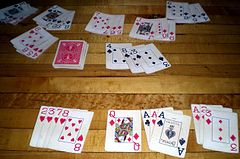Rummy
|
A game of Rummy 500 in progress.
|
|
| Origin | United States |
|---|---|
| Alternative names | Sai rummy, Standard rummy, Basic rummy, Traditional rummy |
| Type | Matching |
| Players | 2+ |
| Age range | All |
| Cards | (52) Varies on game type |
| Deck | French |
| Play | Clockwise |
| Card rank (highest to lowest) | A K Q J 10 9 8 7 6 5 4 3 2 (A) differs by game type |
| Playing time | 15 min. |
| Random chance | Medium |
| Related games | |
| Conquian, Mahjong, Desmoche, Marriage | |
Rummy is a group of matching card games notable for similar gameplay based on matching cards of the same rank or sequence and same suit. The basic goal in any form of rummy is to build melds which consists of sets, three or four of a kind of the same rank; or runs, three or more cards in sequence, of the same suit. You can also have mixed runs in all types of rummy so long as all 7 cards are in order. The original form of rummy is called Sai rummy, Straight Rummy, Standard Rummy, Traditional Rummy, or Basic rummy. The Mexican game of Conquian is considered by games scholar David Parlett to be ancestral to all rummy games, which itself is derived from a Chinese game called Khanhoo and, going even further back, Mahjong. The Rummy principle of drawing and discarding with a view to melding appears in Chinese card games at least in the early 19th century and perhaps as early as the 18th century and is, in fact, the essence of Mah-jong. Rummy is also very popular in India. It is most likely that Indian Rummy is an extension of Gin Rummy and Rummy 500 which originated from the USA. It is played with 13 cards, one or two decks, two or more players and with or without jokers.
For a particular Rummy Hand, each player is provided with 13 cards. The objective of Rummy is to arrange these cards into 4 groups of 3, 3, 3 and 4 cards. These groups can be either Life or Set. A minimum of 2 Lives are required to have a valid arrangement. Once the player has made these groups, he has to submit the cards in groups for validation. This action of submitting the cards is called Show. However, to have a successful Show in Rummy, the player has to arrange the cards into Lives or Sets. This action of arranging the cards in groups is called Meld or Melding.
A meld can either be a set (also known as a book) or a run. A set consists of at least three cards of the same rank and a run consists of at least three consecutive cards of the same suit. This is an almost universal pattern, although there exist minor variations, such as allowing only sets or requiring runs in which its cards have no suits in common. In some games, it is required that runs contain at least four cards. Some games also feature wild cards, which can be used to represent any card in a meld. The number of wild cards in a meld may be restricted.
A fairly large number of cards is used. This varies from one standard deck upwards. There are, for example, games that use five standard decks plus some jokers shuffled together.
...
Wikipedia

